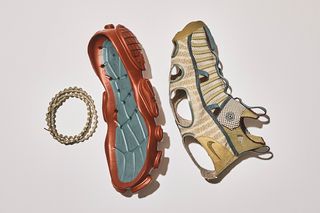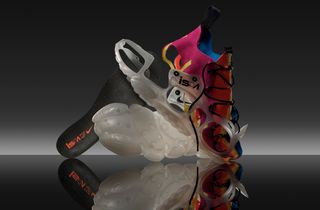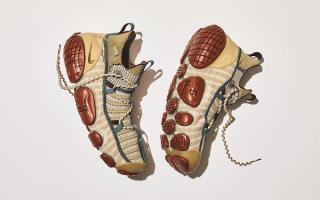Fans of the Swoosh know the brand can design a covetable shoe. What makes that feat to the next level: designing one that’s built to swagger and perform — then be taken apart and recycled.
That was the remit for the Nike ISPA team. ISPA (Improvise; Scavenge; Protect; Adapt) is a Nike design philosophy that challenges creators to experiment, break molds and reimagine products. In this case, it helps move Nike closer to its circular vision — a closed-loop system that yields no waste — to help protect the planet and the future of sport.
This spring, the ISPA team is debuting two head-turning new footwear models that show the brand’s innovative capabilities and foretell its future in a circular design.
For more than 30 years, Nike teams have pursued design solutions in service of the athlete and the planet. They’ve unlocked new, lower-impact materials and created pinnacle performance footwear and iconic lifestyle silhouettes leveraging recycled content. As the climate crisis has intensified for athletes around the world, Nike teams have shifted into a higher gear, embracing circular design principles as creative accelerants. These include the 10 principles outlined in the Nike 2019 Circular Design Guide, an open-source workbook to share learnings and insights with the larger design community and anyone interested in how design can help lessen the impact on the planet.
This season, the ISPA team considered the circular design principle of “disassembly,” or the ability to easily take a product apart to recycle its contents, one of the more challenging principles to implement in footwear design. A good shoe is flexible and durable. Traditionally, designers use glue and other bonding elements to achieve these aims, but that makes a shoe nearly impossible to disassemble and recycle. Recycling shoes usually requires shredding, an energy-intensive process that limits how the recycled materials can be used. Creating a shoe that can be taken apart would reduce the carbon footprint of the product and open up new possibilities for its life cycle.
in partnership with engineering, digital product creation, and development, these shoes are completely informed by the method of making — it really is a case of form following function,” says Darryl Matthews, VP, Catalyst Footwear Product Design. “Our hope is that these ideas and aesthetics become normalized, accelerating our ability to imagine how shoes will continue to evolve in the future.”
Nike ISPA Link

Arriving in June, this futuristic silhouette features three interlocking modules connected without glue that can be taken apart and dropped off at Nike stores offering the Recycling & Donation service.
The midsole is made up of pegs that fit into openings engineered into the upper. This makes for an exceptional fit that is comfortable, stable, and breathes well, according to the 40 athletes who logged some 200 hours in the prototype.


From a manufacturing standpoint, the Link is revolutionary in its simplicity. A pair of Links takes about eight minutes to assemble — a fraction of the average time needed for a traditional sneaker — thanks to a custom-made manufacturing jig and the fact that the shoe doesn’t require the time-intensive gluing process to construct its midsole. Finally, the assembly of the shoe is done without the need for conventional energy-intensive processes like cooling, heating, and conveyer belt systems.
Nike ISPA Link Axis

Make the bold bolder. That’s the vibe of the Link Axis, set to arrive in early 2023, which builds on and advances the Link’s sustainable intent. The Link Axis has a 100 percent recycled polyester Flyknit upper that’s precisely engineered to fit over the outsole (compared to the traditional cut-and-sew method used for the Link), and its 100 percent recycled TPU tooling was achieved by using scrap airbag material.
The shoe also has a 20 percent recycled TPU cage. Because recycling changes some material properties, the cage is an exercise in balancing the desire to use recycled content with the need for durability and tract. The Link Axis is the new pinnacle for disassembly and embodies the circular design principles of material choice, waste avoidance, and refurbishment. The ISPA team continues to explore new developments in this space.


Past Inspiration
Nike has explored disassembly and interlocking modular designs before, in the 2003 Presto Clip, and the 2005 Zvezdochka, created in collaboration with industrial designer Marc Newson. These early iterations paved the way for the ISPA Link and ISPA Link Axis.


For mold-breaking models like the Link and Link Axis to have full impact, the innovation must be scaled. That action is underway. A holistic look at Nike product lines and supply chains are already determining where new approaches can be implemented to reach a wider audience and to move closer to its sustainability goals for 2025 and beyond.
True scale also requires robust cross-industry collaboration to create the business models and infrastructure that make it possible to recycle products. To that end, Nike is building partnerships to grow its recycling capabilities, and it’s investing in product take-back consumer programs across the world that will help grow its ability to repurpose end-of-life products.
As essential: By embracing radical new aesthetics like the Link and Link Axis, Nike is signaling the importance of circular systems for fighting climate change and inviting consumers and the design community to engage in a conversation about it.
To that end, Nike is proud to participate in “Plastic: Remaking Our World,” an exhibition at Germany’s Vitra Design Museum, one of the world’s leading design institutions, from March 26 to September 4, 2022. The exhibit highlights the exploration of design and evolutionary journey behind the ISPA Link Axis, and will be a unique window into the brand’s approach to innovative design with sustainable intent.
With the Link and Link Axis, Nike is further accelerating its move toward a circular, zero-carbon and zero-waste future. As Nike Chief Design Officer John Hoke puts it, “We have a responsibility to consider the complete design solution: how we source, make, use, return and ultimately reimagine product. The goal is to make matter matter more.”




